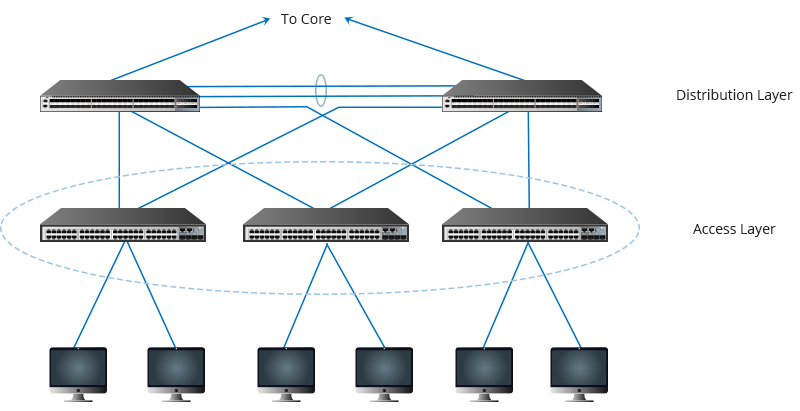In the intricate world of networking, the access layer stands as the gateway to a seamless connection between end-user devices and the broader network infrastructure. At the core of this connectivity lies the access layer switch, a pivotal component that warrants careful consideration for building a robust and efficient network. This article explores the essence of the access layer, delves into how it operates, distinguishes access switches from other types, and provides insights into selecting the right access layer switch.
What is the Access Layer?
The Access Layer, also known as the Edge Layer, in network infrastructure is the first layer within a network topology that connects end devices, such as computers, printers, and phones, to the network. It is where users gain access to the network. This layer typically includes switches and access points that provide connectivity to devices. The Access Layer switches are responsible for enforcing policies such as port security, VLAN segmentation, and Quality of Service (QoS) to ensure efficient and secure data transmission.
For instance, our S5300-12S 12-Port Ethernet layer 3 switch would be an excellent choice for the Access Layer, offering robust security features, high-speed connectivity, and advanced QoS policies to meet varying network requirements.
What is Access Layer Used for?
The primary role of the access layer is to facilitate communication between end devices and the rest of the network. This layer serves as a gateway for devices to access resources within the network and beyond. Key functions of the access layer include:
Device Connectivity
The access layer ensures that end-user devices can connect to the network seamlessly. It provides the necessary ports and interfaces for devices like computers, phones, and printers to establish a connection.
VLAN Segmentation
Virtual LANs (VLANs) are often implemented at the access layer to segment network traffic. This segmentation enhances security, manageability, and performance by isolating traffic into logical groups.
Security Enforcement
Security policies are enforced at the access layer to control access to the network. This can include features like port security, which limits the number of devices that can connect to a specific port.
Quality of Service (QoS)
The access layer may implement QoS policies to prioritize certain types of traffic, ensuring that critical applications receive the necessary bandwidth and minimizing latency for time-sensitive applications.
What is the Role of An Access Layer Switch?
Access switches serve as the tangible interface at the access layer, tasked with linking end devices to the distribution layer switches while guaranteeing the delivery of data packets to those end devices. In addition to maintaining a consistent connection for end users and the higher-level distribution and core layers, an access switch must fulfill the demands of the access layer. This includes streamlining network management, offering security features, and catering to various specific needs that differ based on the network context.
Factors to Consider When Selecting Access Layer Switches
Choosing the right access layer switches is crucial for creating an efficient and reliable network. Consider the following factors when selecting access layer switches for your enterprise:
- Port Density
Evaluate the number of ports required to accommodate the connected devices in your network. Ensure that the selected switch provides sufficient port density to meet current needs and future expansion.
- Speed and Bandwidth
Consider the speed and bandwidth requirements of your network. Gigabit Ethernet is a common standard for access layer switches, but higher-speed options like 10 Gigabit Ethernet may be necessary for bandwidth-intensive applications.
- Power over Ethernet (PoE) Support
If your network includes devices that require power, such as IP phones and security cameras, opt for switches with Power over Ethernet (PoE) support. PoE eliminates the need for separate power sources for these devices.
- Manageability and Scalability
Choose switches that offer easy management interfaces and scalability features. This ensures that the network can be efficiently monitored, configured, and expanded as the organization grows.
- Security Features
Look for switches with robust security features. Features like MAC address filtering, port security, and network access control (NAC) enhance the overall security posture of the access layer.
- Reliability and Redundancy
Select switches with high reliability and redundancy features. Redundant power supplies and link aggregation can contribute to a more resilient access layer, reducing the risk of downtime.
- Cost-Effectiveness
Consider the overall cost of the switch, including initial purchase cost, maintenance, and operational expenses. Balance the features and capabilities of the switch with the budget constraints of your organization.
- Compatibility with Network Infrastructure
Ensure that the chosen access layer switches are compatible with the existing network infrastructure, including core and distribution layer devices. Compatibility ensures seamless integration and optimal performance.
Related Article:How to Choose the Right Access Layer Switch?
Conclusion
In conclusion, the access layer is a critical component of network architecture, facilitating connectivity for end-user devices. Choosing the right access layer switches is essential for building a reliable and efficient network. Consider factors such as port density, speed, PoE support, manageability, security features, reliability, and compatibility when selecting access layer switches for your enterprise. By carefully evaluating these factors, you can build a robust access layer that supports the connectivity needs of your organization while allowing for future growth and technological advancements.

